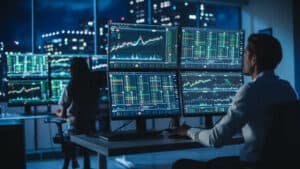At the TradeTech FX US conference in Miami last week, a panel of experts including some of the largest asset managers gathered to discuss what the market is prioritising when asking the ever-hot topic of ‘buy versus build,’ sharing their perspectives and empirical advice for 2024 and beyond.
 Speaking to priorities going forward, one panellist – speaking under Chatham House rules – asserted the importance of combining human perception with automation when looking to streamline workflows.
Speaking to priorities going forward, one panellist – speaking under Chatham House rules – asserted the importance of combining human perception with automation when looking to streamline workflows.
They explained that there’s a real demand from the traders themselves to spend more time bringing insights from what they’re seeing out in the market and focus on investing, while more automation in the meantime eases the load of lower value tasks.
“We must continue to streamline workflows, continue to take the friction out of the workflows and continue to automate lower value trades so that traders can focus on the high value.”
The same speaker also suggested that while ensuring automation truly does lead to best execution is the bottom line, when it comes to addressing challenges posed by workflow processes and creating solutions – so-called ‘mouse-traps’ – macro events cannot be overlooked and should be incorporated into the analysis in order to equip traders with the right tools.
In a similar vein, one expert highlighted that the thought leadership which providers can potentially provide is often an unsung benefit, and one which can be increasingly valuable.
“Regulations are changing, so are [providers] going to help support those developments, what does their tech development look like but also are they going to get me to where I need to be if there’s something I need to internally resource and build myself?
“In addition, support and networking is actually really important and I find it very valuable in my seat because if we have vendors that we can lean on and ask if a problem is common, it’s really helpful.”
Another panellist suggested that, where there are a number of different traders and classes and players are wearing multiple different hats, the challenge is focused on connecting the different systems in the most efficient way possible.
“The key will be to find how to leverage interoperability in terms of the technology in order to get the different apps together so they can work seamlessly.
“We don’t necessarily need to kitchen sink all of our systems […] but we could connect them instead of building something from scratch and saying ‘okay this will be the be all cross-asset solution’. Ultimately, I think what we’re looking towards in terms of the technology is having the same architecture behind the scenes so we can sort of connect everything together.”
One speaker added that the panel – as consumers of technology and innovation – share a similar issue of scarce resources, where a limited number of traders look to do the best with what they have and further enhanced the importance of relationships and “insightful, full conversations”.
Further, the same expert highlighted the relevance of market fragmentation when it comes to the industry’s relationship with technology.
“Markets are fragmented even more today, hence why we need technology. We need data and it’s not just a check box approach. We really want to get inside conversations […] we can enhance and improve together to evolve markets, I believe, into a much better position over the next three to five years.”
When it comes to the topic of integrated platforms where interoperability is of the upmost importance, the panel agreed that while firms of all sizes face similar problems, there is a clear disparity in terms of the approach to solutions and the path these actors choose to pursue and the priorities at the fore between actors – which should make for interesting, wide-reaching innovation going forward.